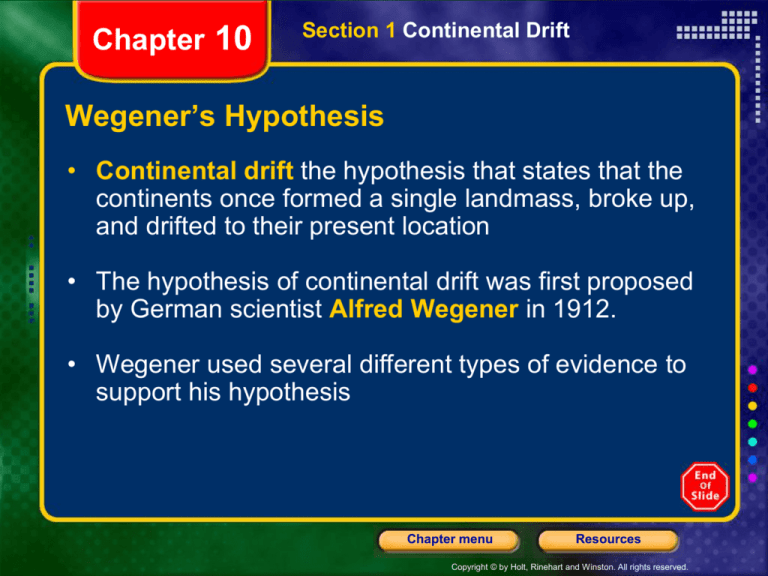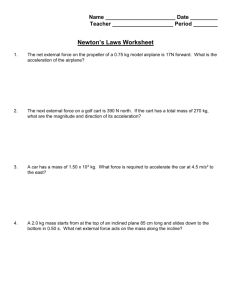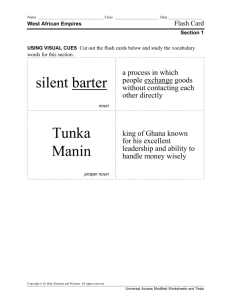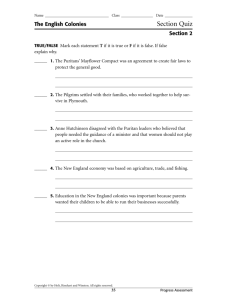
Chapter 10
Section 1 Continental Drift
Wegener’s Hypothesis
• Continental drift the hypothesis that states that the
continents once formed a single landmass, broke up,
and drifted to their present location
• The hypothesis of continental drift was first proposed
by German scientist Alfred Wegener in 1912.
• Wegener used several different types of evidence to
support his hypothesis
Chapter menu
Resources
Copyright © by Holt, Rinehart and Winston. All rights reserved.
9.1 Continental Drift
An Idea Before Its Time
Wegener’s continental drift hypothesis stated that the continents
had once been joined to form a single supercontinent.
• Wegener proposed that the supercontinent, Pangaea, began to break
apart 200 million years ago and form the present landmasses.
Chapter menu
Resources
Copyright © by Holt, Rinehart and Winston. All rights reserved.
Breakup of Pangaea
Chapter menu
Resources
Copyright © by Holt, Rinehart and Winston. All rights reserved.
Chapter 10
Section 1 Continental Drift
Wegener’s Hypothesis, continued
Wegener’s Evidence
• Fossil Evidence: fossils of the same plants and
animals could be found in areas of continents that
had once been connected.
• Evidence from Rock Formations: ages and types of
rocks in the coastal regions of widely separated
areas matched closely.
Chapter menu
Resources
Copyright © by Holt, Rinehart and Winston. All rights reserved.
Climatic Evidence: changes in climatic
patterns suggested the continents had not
always been located where they are now.
Chapter menu
Resources
Copyright © by Holt, Rinehart and Winston. All rights reserved.
Chapter 10
Section 1 Continental Drift
Wegener’s Hypothesis, continued
Similar rock formations and fossil evidence supported Wegener’s
hypothesis.
Chapter menu
Resources
Copyright © by Holt, Rinehart and Winston. All rights reserved.
Chapter menu
Resources
Copyright © by Holt, Rinehart and Winston. All rights reserved.
Chapter 10
Section 1 Continental Drift
Wegener’s Hypothesis, continued
Missing Mechanisms
• Wegener proposed that the continents moved by
plowing through the rock of the ocean floor.
• Wegener’s ideas were strongly opposed.
• Wegener’s mechanism was disproved by geologic
evidence.
• Wegener spent the rest of his life searching for a
mechanism for the movement of continents.
Chapter menu
Resources
Copyright © by Holt, Rinehart and Winston. All rights reserved.
9.1 Continental Drift
Rejecting the Hypothesis
A New Theory Emerges
• Wegener could not provide an explanation of exactly what made the
continents move. News technology lead to findings which then lead to
a new theory called plate tectonics.
Chapter menu
Resources
Copyright © by Holt, Rinehart and Winston. All rights reserved.
Chapter 10
Section 1 Continental Drift
Mid-Ocean Ridges
• Mid-ocean ridge a long, undersea mountain chain
that has a steep, narrow valley at its center, that
forms as magma rises from the asthenosphere, and
that creates new oceanic lithosphere (sea floor) as
tectonic plates move apart
Chapter menu
Resources
Copyright © by Holt, Rinehart and Winston. All rights reserved.
Chapter 10
Section 1 Continental Drift
Mid-Ocean Ridges, continued
In 1947, a group of scientists set out to map the MidAtlantic Ridge. While studying the Mid-Atlantic Ridge,
scientists noticed two surprising trends.
1. The sediment that covers the sea floor is thinner
closer to a ridge than it is farther from the ridge
2. The ocean floor is very young. Rocks on land are as
old as 3.8 billion years. None of the oceanic rocks are
more than 175 million years old.
Chapter menu
Resources
Copyright © by Holt, Rinehart and Winston. All rights reserved.
Chapter 10
Section 1 Continental Drift
Mid-Ocean Ridges, continued
Rocks closer to a mid-ocean ridge are younger than rocks farther
from the ridge. Rocks closer to the ridge are covered with less
sediment than rocks farther from the ridge.
Chapter menu
Resources
Copyright © by Holt, Rinehart and Winston. All rights reserved.
Chapter 10
Section 1 Continental Drift
Sea-Floor Spreading, continued
Chapter menu
Resources
Copyright © by Holt, Rinehart and Winston. All rights reserved.
Chapter 10
Section 1 Continental Drift
Sea-Floor Spreading
• Sea-floor spreading the process by which new
oceanic lithosphere (sea floor) forms as magma rises
to Earth’s surface and solidifies at a mid-ocean ridge
• Paleomagnetism the study of the alignment of
magnetic minerals in rock, specifically as it relates to
the reversal of Earth’s magnetic poles; also the
magnetic properties that rock acquires during
formation
Chapter menu
Resources
Copyright © by Holt, Rinehart and Winston. All rights reserved.
Chapter 10
Section 1 Continental Drift
Sea-Floor Spreading, continued
• In the late 1950’s geologist Harry Hess proposed that
the valley at the center of the mid-ocean ridge was a
crack, or rift, in Earth’s crust.
• As the ocean floor moves away from the ridge,
molten rock, or magma, rises to fill the crack.
• Hess suggested that if the sea floor is moving, the
continents might be moving also.
• He suggested this might be the mechanism that
Wegener was searching for.
Chapter menu
Resources
Copyright © by Holt, Rinehart and Winston. All rights reserved.
Chapter 10
Section 1 Continental Drift
Sea-Floor Spreading, continued
Chapter menu
Resources
Copyright © by Holt, Rinehart and Winston. All rights reserved.
9.4 Testing Plate Tectonics
Evidence for Plate Tectonics
Paleomagnetism is the natural remnant magnetism in rock bodies;
this permanent magnetization acquired by rock can be used to
determine the location of the magnetic poles at the time the rock
became magnetized.
•
•
Normal polarity—when rocks show the same magnetism as the present
magnetism field
Reverse polarity—when rocks show the opposite magnetism as the
present magnetism field
Chapter menu
Resources
Copyright © by Holt, Rinehart and Winston. All rights reserved.
Polarity of the Ocean Crust
Chapter menu
Resources
Copyright © by Holt, Rinehart and Winston. All rights reserved.
Chapter 10
Section 2 The Theory of Plate
Tectonics
Causes of Plate Motion
1. Convection Warm fluids in the mantle are less
dense and rise to the surface. Cooler fluids sink
away from the surface. This drags the plates with
the currents.
2. Density the plate with the higher density will sink
below the less dense plate. Oceanic crust is thinner,
but more dense than continental crust, so oceanic
crust will sink below continental crust. This is called
subduction.
Chapter menu
Resources
Copyright © by Holt, Rinehart and Winston. All rights reserved.
Chapter 10
Section 2 The Theory of Plate
Tectonics
Causes of Plate Motion, continued
• The convection process can be modeled by boiling
water in a pot on the stove. As the water at the
bottom of the pot is heated, the water at the bottom
expands and becomes less dense than the cooler
water above it.
• The cooler, denser water sinks, and the warmer
water rises to the surface to create a cycle called a
convection cell.
Chapter menu
Resources
Copyright © by Holt, Rinehart and Winston. All rights reserved.
Chapter 10
Section 2 The Theory of Plate
Tectonics
Causes of Plate Motion, continued
Mantle Convection
• As the hot material rises, the cooler, denser material
flows away from the hot material and sinks into the
mantle to replace the rising material.
• As the mantle material moves, it drags the overlying
tectonic plates along with it.
Chapter menu
Resources
Copyright © by Holt, Rinehart and Winston. All rights reserved.
Chapter 10
Section 2 The Theory of Plate
Tectonics
Causes of Plate Motion, continued
• Insert TT
Chapter menu
Resources
Copyright © by Holt, Rinehart and Winston. All rights reserved.
Chapter 10
Section 3 The Changing
Continents
The Supercontinent Cycle, continued
Geography of the Future
• As tectonic plates continue to move, Earth’s
geography will change dramatically.
• Scientists predict that in 250 million years, the
continents will come together again to form a new
supercontinent.
Chapter menu
Resources
Copyright © by Holt, Rinehart and Winston. All rights reserved.
Chapter 10
Tectonic Plates
Chapter menu
Resources
Copyright © by Holt, Rinehart and Winston. All rights reserved.









